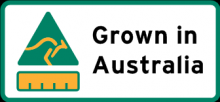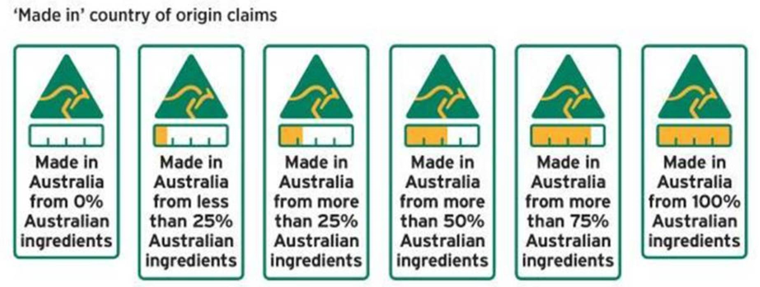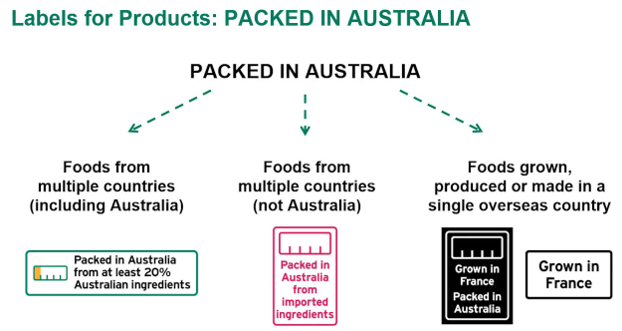29 Aug Priority Food Labelling
Most Australian packaged foods including olive oil and other olive products are ‘priority foods’ for the purposes of CoOL labelling.
Standard origin claims are used to communicate the location in which a food was grown, produced, made or packed. There are specific criteria that must be met for the use of each of these terms.
Grown in
A food or ingredient is grown in a particular country if it:
was materially increased in size or materially altered in substance in that country by natural development, such as fruit and vegetables or whole fish
germinated or otherwise arose in, or was issued in, that country. This would include wheat, oats or nuts
was harvested, extracted or otherwise derived from an organism that has been materially increased in size or materially altered in substance in that country. This would include cow’s milk, sugar, fruit juice, meat or eggs.
A food with multiple ingredients is also ‘grown’ in a country if each of its significant ingredients were grown in that country and all of its processing occurred in that country, such as breakfast cereal.

Produced in (product of)
A food is produced in a particular country if each of its significant ingredients were grown or otherwise wholly obtained in that country and all (or virtually all) of its processing occurred in that country. ‘Wholly obtained’ refers to foods or ingredients that originate in a country but are not necessarily ‘grown’, such as water sourced in Australia, salt harvested in Australia, or almond milk derived from Australian grown almonds and Australian sourced water.

Made in
A food is made in a country if it underwent its last substantial transformation in that country. The emphasis of this origin claim is therefore on the production of a food rather than its content.
A food will be substantially transformed in a country if it:
was grown or produced in that country, or
is, as a result of one or more processes in that country, fundamentally different in identity, nature or essential character from all of its ingredients or components that were imported into that country.
Foods that are able to carry a claim that they were ‘grown in’ or ‘produced in’ a particular country can therefore also safely claim to have been ‘made in’ that country. As to whether a product with imported ingredients or components has been substantially transformed, this will require a closer assessment of the processing undertaken to the ingredients in that country and its effect on the final product.

Packed in
Depending on the circumstances, the Information Standard may require, or permit, a food to be labelled with information about where it was packaged. Evaluation of Country of Origin Labelling for Food 6
Under the Information Standard, a food that cannot claim to have been ‘grown’, ‘produced’ or ‘substantially transformed’ (i.e. ‘made’) in a country, will only be able to claim to have been ‘packed in’ that country. For example, if an Australian food processor slices, freezes and packages Australian carrots and New Zealand beans for sale, the mixed vegetables would be unable to claim to have been grown, produced or ‘made’ in either country. Accordingly, the product would only be able to claim to have been ‘Packed in Australia’. In this circumstance, extra text may be added to labels to highlight the origin of specific ingredients as long as the ingredients named are sourced exclusively from one country.

Australian content
While statements about where a product is grown, produced, made or packed provides consumers with information about the location of a food’s production, the CoOL reforms also provide consumers with information about the origin of the ingredients that go into a product. If a food is grown, produced, made or packed in Australia, its country of origin labelling must disclose the proportion of Australian content in the product. Those products are not, however, required to provide information about the source of those ingredients that were sourced from outside Australia.
Displaying the proportion of Australian content is optional for all other food, including food made or packed overseas with up to 100 per cent Australian content.
‘Australian content’ means ingredients or parts of compound ingredients that were exclusively grown or produced in Australia.
Imported food
Food that is not grown, produced, made or packed in Australia is classified as imported food. Under the Information Standard, imported priority food must, at a minimum, carry a country of origin text statement, such as ‘Made in China’ or ‘Product of Brazil’, in a clearly defined box. Non-priority foods must bear a text statement about where the food was grown, produced or made, such as ‘Product of Thailand’.
If an imported food cannot claim to have been grown, produced or made in a single overseas country, it must instead carry a ‘packed in’ statement. In this instance, the label must:
identify the country where it was packed, and
indicate that the food is of multiple origins, or from imported ingredients.

Non-priority food labelling
The Information Standard only requires non-priority foods to carry a country of origin text statement about where the food was grown, produced or made. This statement need not be in a box, but it must be legible and prominent against the background of the label.
There are seven non-priority food categories:
- seasonings
- confectionary
- biscuits and snack food
- bottled water
- soft drinks and sports drinks
- tea and coffee, and
- alcoholic beverages.
Online sales
The CoOL reforms apply equally to food products sold in physical stores and food sold through online stores, insofar as the physical packaging of food sold online must meet the same CoOL requirements as food sold in physical stores. While online retailers are encouraged to display CoOL information as part of their advertisement of foods on their websites, the Information Standard does not require this.
